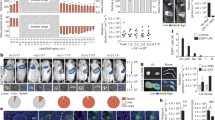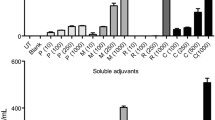Abstract
Purpose
This paper aims to investigate the immunoinhibitory properties of a lymph nodes-targeting suppressive oligonucleotide (ODN) for the potential treatment of autoimmune diseases or chronic inflammation.
Methods
Synthetic suppressive ODN engineered with an albumin-binding diacyl lipid at the 5′-terminal (lipo-ODN) was synthesized. In vitro and in vivo experiments were designed to compare the immune suppressive properties of lipo-ODN and unmodified ODN. Cellular uptake and distribution, inhibition of Toll-like receptor (TLR) activation, lymph nodes (LN) draining, and the suppression of antigen-specific immune responses in an ovalbumin protein model was investigated.
Results
Compared to unmodified ODN, lipid functionalized suppressive ODN demonstrated enhanced cellular uptake and TLR-9 specific immune suppression in TLR reporter cells. Additionally, injection of a low dose of lipid-modified suppressive ODN, but not the unconjugated ODN, accumulated in the draining LNs and exhibited potent inhibition of antigen-specific CD8+ T cell and B cell responses in vivo.
Conclusions
Targeting suppressive ODN to antigen presenting cells (APCs) in the local LNs is an effective approach to amplify the immune modulation mediated by ODN containing repetitive TTAGGG motif. This approach might be broadly applicable to target molecular adjuvants to the key immune cells in the LNs draining from disease site, providing a simple strategy to improve the efficacy of many molecular immune modulators.




Similar content being viewed by others
Abbreviations
- BSA:
-
Bovine serum albumin
- CpG ODN:
-
CpG oligodeoxynucleotides
- DAPI:
-
4′,6-diamidino-2-phenylindole
- DC 2.4:
-
Dendritic cell 2.4
- ELISA:
-
Enzyme-linked immunosorbent assay
- FAM:
-
Fluorescein amidite
- IgG:
-
Immunoglobulin G
- LN:
-
Lymph node
- LPS:
-
Lipopolysaccharide
- MHC:
-
Major histocompatibility complex
- OVA:
-
Ovalbumin
- PBS:
-
Phosphate buffered saline
- SEAP:
-
Secreted embryonic alkaline phosphatase
- Sup-ODN:
-
Suppressive oligodeoxynucleotides
- TLR-9:
-
Toll-like receptor 9
References
Akira S, Takeda K, Kaisho T. Toll-like receptors: critical proteins linking innate and acquired immunity. Nat Immunol. 2001;2(8):675–80.
Takeda K, Kaisho T, Akira S. Toll-like receptors. Annu Rev Immunol. 2003;21(1):335–76.
Barrat FJ, Coffman RL. Development of TLR inhibitors for the treatment of autoimmune diseases. Immunol Rev. 2008;223(1):271–83.
Capolunghi F, Rosado MM, Cascioli S, Girolami E, Bordasco S, Vivarelli M, et al. Pharmacological inhibition of TLR9 activation blocks autoantibody production in human B cells from SLE patients. Rheumatology. 2010;49(12):2281–9.
Mills KH. TLR-dependent T cell activation in autoimmunity. Nat Rev Immunol. 2011;11(12):807–22.
Barrat FJ, Meeker T, Gregorio J, Chan JH, Uematsu S, Akira S, et al. Nucleic acids of mammalian origin can act as endogenous ligands for toll-like receptors and may promote systemic lupus erythematosus. J Exp Med. 2005;202(8):1131–9.
Firestein GS. Evolving concepts of rheumatoid arthritis. Nature. 2003;423(6937):356–61.
Huang Q-Q, Pope RM. The role of toll-like receptors in rheumatoid arthritis. Curr Rheumatol Rep. 2009;11(5):357–64.
Marshak-Rothstein A. Toll-like receptors in systemic autoimmune disease. Nat Rev Immunol. 2006;6(11):823–35.
Guiducci C, Tripodo C, Gong M, Sangaletti S, Colombo MP, Coffman RL, et al. Autoimmune skin inflammation is dependent on plasmacytoid dendritic cell activation by nucleic acids via TLR7 and TLR9. J Exp Med. 2010;207(13):2931–42. https://doi.org/10.1084/jem.20101048.
Gursel I, Gursel M, Yamada H, Ishii KJ, Takeshita F, Klinman DM. Repetitive elements in mammalian telomeres suppress bacterial DNA-induced immune activation. J Immunol. 2003;171(3):1393–400.
Bayik D, Gursel I, Klinman DM. Structure, mechanism and therapeutic utility of immunosuppressive oligonucleotides. Pharmacol Res. 2016;105:216–25.
Tostanoski LH, Chiu YC, Andorko JI, Guo M, Zeng X, Zhang P, et al. Design of polyelectrolyte multilayers to promote immunological tolerance. ACS Nano. 2016;10:9334–45.
Shirota H, Gursel M, Klinman DM. Suppressive oligodeoxynucleotides inhibit Th1 differentiation by blocking IFN-γ-and IL-12-mediated signaling. J Immunol. 2004;173(8):5002–7.
Flierl U, Nero TL, Lim B, Arthur JF, Yao Y, Jung SM, et al. Phosphorothioate backbone modifications of nucleotide-based drugs are potent platelet activators. J Exp Med. 2015;212(2):129–37.
Iannitti T, Cesar Morales-Medina J, Palmieri B. Phosphorothioate oligonucleotides: effectiveness and toxicity. Curr Drug Targets. 2014;15(7):663–73.
Benaglio F, Vitolo B, Scarabelli M, Binda E, Bugatti S, Caporali R, et al. The draining lymph node in rheumatoid arthritis: current concepts and research perspectives. Biomed Res Int. 2015;2015:420251.
Trevaskis NL, Kaminskas LM, Porter CJ. From sewer to saviour [mdash] targeting the lymphatic system to promote drug exposure and activity. Nat Rev Drug Discov. 2015;14(11):781–803.
Liu H, Moynihan KD, Zheng Y, Szeto GL, Li AV, Huang B, et al. Structure-based programming of lymph-node targeting in molecular vaccines. Nature. 2014;507(7493):519–22.
Liu H, Kwong B, Irvine DJ. Membrane anchored immunostimulatory oligonucleotides for in vivo cell modification and localized immunotherapy. Angew Chem Int Ed Eng. 2011;50(31):7052–5.
Krieg AM, Yi A-K, Matson S, Waldschmidt TJ, Bishop GA, Teasdale R, et al. CpG motifs in bacterial DNA trigger direct B-cell activation. Nature. 1995;374(6522):546–9.
Raouane M, Desmaële D, Urbinati G, Massaad-Massade L, Couvreur P. Lipid conjugated oligonucleotides: a useful strategy for delivery. Bioconjug Chem. 2012;23(6):1091–104.
Yu C, An M, Li M, Liu H. Immunostimulatory properties of lipid modified CpG Oligonucleotides. Mol Pharm. 2017;14(8):2815–23.
Kandimalla ER, Yu D, Zhao Q, Agrawal S. Effect of chemical modifications of cytosine and guanine in a CpG-motif of oligonucleotides: structure–immunostimulatory activity relationships. Bioorg Med Chem. 2001;9(3):807–13.
Klinman DM, Tross D, Klaschik S, Shirota H, Sato T. Therapeutic applications and mechanisms underlying the activity of immunosuppressive oligonucleotides. Ann N Y Acad Sci. 2009;1175:80–8.
Lenert PS. Classification, mechanisms of action, and therapeutic applications of inhibitory oligonucleotides for toll-like receptors (TLR) 7 and 9. Mediat Inflamm. 2010;2010:986596.
Liu H, Irvine DJ. Guiding principles in the design of molecular bioconjugates for vaccine applications. Bioconjug Chem. 2015;26(5):791–801.
Faries MB, Bedrosian I, Reynolds C, Nguyen HQ, Alavi A, Czerniecki BJ. Active macromolecule uptake by lymph node antigen-presenting cells: a novel mechanism in determining sentinel lymph node status. Ann Surg Oncol. 2000;7(2):98–105.
Suarez-Farinas M, Arbeit R, Jiang W, Ortenzio FS, Sullivan T, Krueger JG. Suppression of molecular inflammatory pathways by toll-like receptor 7, 8, and 9 antagonists in a model of IL-23-induced skin inflammation. PLoS One. 2013;8(12):e84634.
Balak DM, van Doorn MB, Arbeit RD, Rijneveld R, Klaassen E, Sullivan T, et al. IMO-8400, a toll-like receptor 7, 8, and 9 antagonist, demonstrates clinical activity in a phase 2a, randomized, placebo-controlled trial in patients with moderate-to-severe plaque psoriasis. Clin Immunol (Orlando FL). 2017;174:63–72.
Karbach J, Neumann A, Wahle C, Brand K, Gnjatic S, Jager E. Therapeutic administration of a synthetic CpG oligodeoxynucleotide triggers formation of anti-CpG antibodies. Cancer Res. 2012;72(17):4304–10.
Author information
Authors and Affiliations
Corresponding author
Rights and permissions
About this article
Cite this article
Yu, C., An, M., Jones, E. et al. Targeting Suppressive Oligonucleotide to Lymph Nodes Inhibits Toll-like Receptor-9-Mediated Activation of Adaptive Immunity. Pharm Res 35, 56 (2018). https://doi.org/10.1007/s11095-018-2344-2
Received:
Accepted:
Published:
DOI: https://doi.org/10.1007/s11095-018-2344-2




